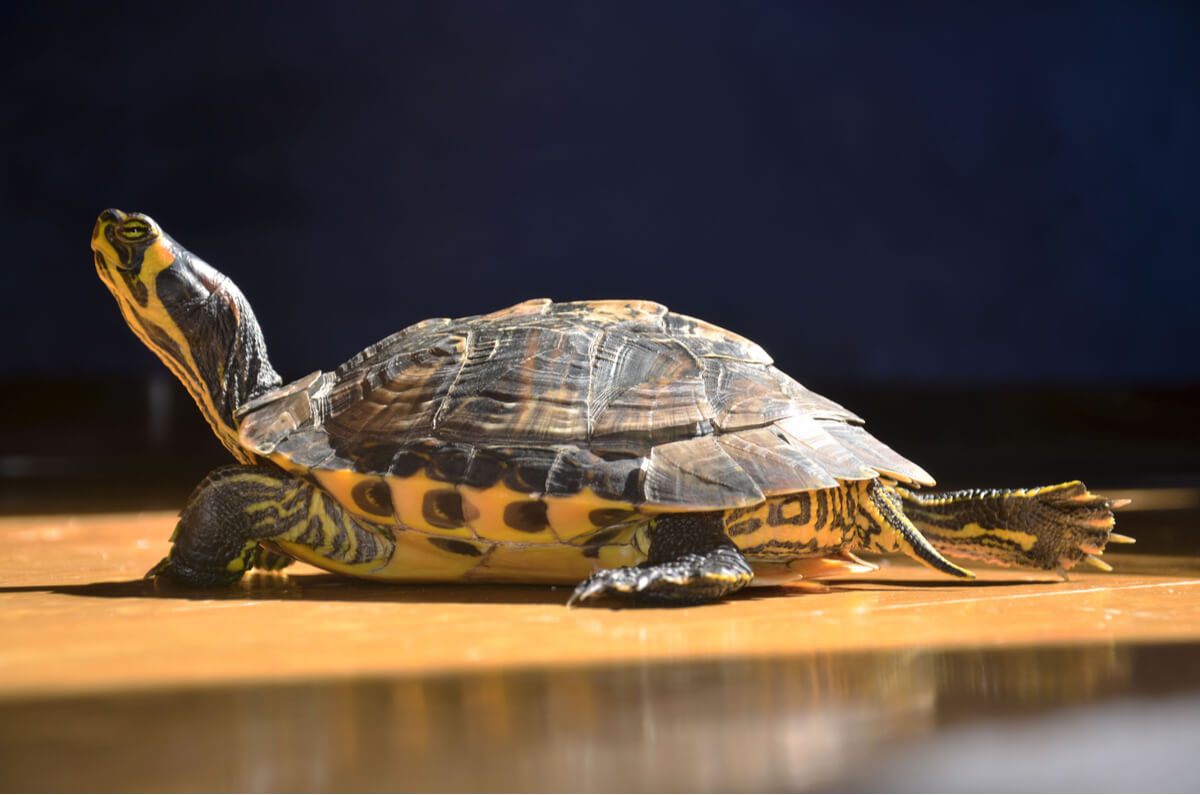The Behavior of Turtles and Tortoises

The appearance of legends regarding these chelonians is perfectly justified, as humans have observed specimens that seemed to survive from generation after generation. For this reason, research on the behavior of turtles arises from a desire to get to know these animals better – a symbol of wisdom and longevity.
Turtles can be grouped into 3 groups according to their habitat and lifestyle: marine, terrestrial and aquatic. In this article you can learn about the differences between them and how they behave.
Characteristics of turtles
Turtles (order Testudine) differ from other reptiles mainly by having a shell that protects the internal organs and is welded to the spinal column. In its ventral part, although softer, it also has a protective structure called the plastron.
Both the shell and the plastron are made up of an outer layer of keratin and an inner layer of bone.
At present, 250 species of turtles are recognized, distributed in 2 suborders (Cryptodira and Pleurodira) and 15 families. Experts believe that the first turtles appeared between 220 and 210 million years ago, during the Triassic, which makes them the oldest existing reptiles.
The behavior of turtles, as well as their characteristics and way of life, vary enormously from one group to another. We’re now going to get to know them in detail, with all their peculiarities.
Behavior of turtles
Most turtles belong to the Testudinidae family, which includes 42 species. At this point, you may be wondering what is the difference is between a turtle and a tortoise – please see this article to clear this point up! This family of turtles (tortoises) is characterized by their thick and strong limbs, as well as their spherical and raised carapace. These chelonians spend more than 50% of their time resting. Most of them are herbivores and perform seed dispersal functions in their ecosystems.
Shelter behavior
To ensure a safe rest, tortoises often look for secluded and hidden places in the vegetation. When they find a suitable place, they stand still and put their head and limbs inside the shell.
It isn’t easy to make them come out: the turtles exert an enormous force to retract and a predator would find it really difficult to be able to grab one of their limbs.
Reproduction and copulation
Mating rituals can vary by species, but the male is generally observed trying to immobilize the female, first surrounding her and then holding her to rise above her shell. If the female doesn’t dismount him, copulation begins.
Alarmed behavior
What is generally observed when a turtle becomes alarmed is that it stretches its neck and lifts its head. In this way, it can observe its surroundings better and respond more quickly to threats.
Agonistic behavior
Although it’s atypical to find this in the behavior of turtles (tortoises), chases and assaults have occasionally been documented, usually with bites. Before engaging in an attack, they may open their mouths – like a yawn – as a threat.

The behavior of sea turtles
Belonging to the Chelonioidea superfamily, sea turtles are characterized by being perfectly adapted to life in the sea, as they only go ashore to spawn. At present, 7 species of sea turtles are known, belonging to the Cheloniidae and Dermochelydae families.
Due to their lifestyle, the details of their behavior are difficult to document. They’re known to be solitary, although they can share foraging space with others.
Courtship, reproduction, and spawning
Sea turtles go through a reproductive period prior to migration and spawning. The males can fight among themselves to find a mate, since they are polygamous species, and mate with more than one individual.
Most females migrate after this period, some to spawn on the same beaches where they were born. They come out of the sea to create the nest by digging in the sand, a slow and costly process for them. They do it at night, which is when they are least in danger.
When the nest is ready, the turtles lay their eggs. Depending on the species, they can lay 80 to 160 eggs. If, during the process, they feel threatened, they interrupt the deposition and leave the nest. When they finish, they cover the eggs with sand and leave.
During spawning, they secrete the salts accumulated in the body through glands located in the eyes, giving the impression that they “cry”.
Migration of sea turtles
Sea turtles are the only reptiles that exhibit long-distance migratory behavior. In addition to spawning, they may take these routes to seek new foraging and mating sites.
It’s believed that the migratory process in turtles can be guided by biological compasses, sea currents, water temperature and even by chemical concentrations in the water.
The longest migration documented to date was that of two leatherback turtles (Dermatochelys coriacea), which traveled 12,000 kilometers on their spawning route. The researchers attached GPS devices to them to track their entire journey.
The behavior of the hatchlings
Newborns break the egg by means of an extension of the upper part of their mouth, similar to a beak. Sometimes, after a couple of days, they push the sand away with their fins and wait for the night to emerge all together and run towards the sea.
Using the moon to orient themselves, the hatchlings exhibit a behavior called a swimming frenzy, in which they swim hard against the surf to enter the sea. This is an innate behavior that gives them an advantage against predators that attack them on the way to the water.

The behavior of freshwater turtles
Finally, freshwater turtles or aquatic turtles represent 60% of the species in their order. They have a wide distribution and great ecological diversity, occupying rivers, lakes, and lagoons.
In contrast to its marine relatives, its limbs combine swimming with land travel. They lead an amphibious lifestyle, spending most of their time in the water but frequently venturing ashore to sunbathe, reproduce or feed.
Aggressive behavior
Agonistic behavior patterns are relatively more frequent in freshwater turtles. Normally, they occur in defense of a territory, with threats such as the aforementioned yawn. Males open their mouths and may even snort.
Persecution and avoidance behaviors have also been described. In these cases, one specimen follows another to eject it from the area or compete for mating; sometimes biting and pushing are observed.
Territoriality of freshwater turtles
Although some species live in groups, such as the red-eared slider (Trachemys scripta), they’re usually solitary and are only sought after during reproduction. That’s why it is common to find territorial behavior in them that includes aggressiveness against their peers.
Reproductive behavior
The behavior of aquatic turtles during reproduction includes behavior that varies by species. Some of the best known are stroking the female’s face with small and rapid spasms of his nails, chasing her or giving her small bites.
Many species of these chelonians exhibit parental care by the female. They tend to take care of their nests, removing unviable eggs and monitoring the temperature of the eggs during incubation. Later, the mothers can be seen protecting the young from predator attacks.
Behavior associated with thermoregulation
Turtles, as the ectothermic animals that they are, show behavior patterns focused on keeping their body temperature stable. Like terrestrial turtles, freshwater turtles practice atmospheric basking, exposing themselves to the sun, either on land or floating in the water.
Defense of freshwater turtles
Like tortoises, they can retract into their shells when threatened. In this way, they have a certain resistance against attacks and harassment from predators.

When it comes to the behavior of turtles, we need to study the details regarding each species, as each one of them has its own peculiarities. This, although it raises more questions than answers, only leaves the door open to continue discovering the incredible world of these animals.
The appearance of legends regarding these chelonians is perfectly justified, as humans have observed specimens that seemed to survive from generation after generation. For this reason, research on the behavior of turtles arises from a desire to get to know these animals better – a symbol of wisdom and longevity.
Turtles can be grouped into 3 groups according to their habitat and lifestyle: marine, terrestrial and aquatic. In this article you can learn about the differences between them and how they behave.
Characteristics of turtles
Turtles (order Testudine) differ from other reptiles mainly by having a shell that protects the internal organs and is welded to the spinal column. In its ventral part, although softer, it also has a protective structure called the plastron.
Both the shell and the plastron are made up of an outer layer of keratin and an inner layer of bone.
At present, 250 species of turtles are recognized, distributed in 2 suborders (Cryptodira and Pleurodira) and 15 families. Experts believe that the first turtles appeared between 220 and 210 million years ago, during the Triassic, which makes them the oldest existing reptiles.
The behavior of turtles, as well as their characteristics and way of life, vary enormously from one group to another. We’re now going to get to know them in detail, with all their peculiarities.
Behavior of turtles
Most turtles belong to the Testudinidae family, which includes 42 species. At this point, you may be wondering what is the difference is between a turtle and a tortoise – please see this article to clear this point up! This family of turtles (tortoises) is characterized by their thick and strong limbs, as well as their spherical and raised carapace. These chelonians spend more than 50% of their time resting. Most of them are herbivores and perform seed dispersal functions in their ecosystems.
Shelter behavior
To ensure a safe rest, tortoises often look for secluded and hidden places in the vegetation. When they find a suitable place, they stand still and put their head and limbs inside the shell.
It isn’t easy to make them come out: the turtles exert an enormous force to retract and a predator would find it really difficult to be able to grab one of their limbs.
Reproduction and copulation
Mating rituals can vary by species, but the male is generally observed trying to immobilize the female, first surrounding her and then holding her to rise above her shell. If the female doesn’t dismount him, copulation begins.
Alarmed behavior
What is generally observed when a turtle becomes alarmed is that it stretches its neck and lifts its head. In this way, it can observe its surroundings better and respond more quickly to threats.
Agonistic behavior
Although it’s atypical to find this in the behavior of turtles (tortoises), chases and assaults have occasionally been documented, usually with bites. Before engaging in an attack, they may open their mouths – like a yawn – as a threat.

The behavior of sea turtles
Belonging to the Chelonioidea superfamily, sea turtles are characterized by being perfectly adapted to life in the sea, as they only go ashore to spawn. At present, 7 species of sea turtles are known, belonging to the Cheloniidae and Dermochelydae families.
Due to their lifestyle, the details of their behavior are difficult to document. They’re known to be solitary, although they can share foraging space with others.
Courtship, reproduction, and spawning
Sea turtles go through a reproductive period prior to migration and spawning. The males can fight among themselves to find a mate, since they are polygamous species, and mate with more than one individual.
Most females migrate after this period, some to spawn on the same beaches where they were born. They come out of the sea to create the nest by digging in the sand, a slow and costly process for them. They do it at night, which is when they are least in danger.
When the nest is ready, the turtles lay their eggs. Depending on the species, they can lay 80 to 160 eggs. If, during the process, they feel threatened, they interrupt the deposition and leave the nest. When they finish, they cover the eggs with sand and leave.
During spawning, they secrete the salts accumulated in the body through glands located in the eyes, giving the impression that they “cry”.
Migration of sea turtles
Sea turtles are the only reptiles that exhibit long-distance migratory behavior. In addition to spawning, they may take these routes to seek new foraging and mating sites.
It’s believed that the migratory process in turtles can be guided by biological compasses, sea currents, water temperature and even by chemical concentrations in the water.
The longest migration documented to date was that of two leatherback turtles (Dermatochelys coriacea), which traveled 12,000 kilometers on their spawning route. The researchers attached GPS devices to them to track their entire journey.
The behavior of the hatchlings
Newborns break the egg by means of an extension of the upper part of their mouth, similar to a beak. Sometimes, after a couple of days, they push the sand away with their fins and wait for the night to emerge all together and run towards the sea.
Using the moon to orient themselves, the hatchlings exhibit a behavior called a swimming frenzy, in which they swim hard against the surf to enter the sea. This is an innate behavior that gives them an advantage against predators that attack them on the way to the water.

The behavior of freshwater turtles
Finally, freshwater turtles or aquatic turtles represent 60% of the species in their order. They have a wide distribution and great ecological diversity, occupying rivers, lakes, and lagoons.
In contrast to its marine relatives, its limbs combine swimming with land travel. They lead an amphibious lifestyle, spending most of their time in the water but frequently venturing ashore to sunbathe, reproduce or feed.
Aggressive behavior
Agonistic behavior patterns are relatively more frequent in freshwater turtles. Normally, they occur in defense of a territory, with threats such as the aforementioned yawn. Males open their mouths and may even snort.
Persecution and avoidance behaviors have also been described. In these cases, one specimen follows another to eject it from the area or compete for mating; sometimes biting and pushing are observed.
Territoriality of freshwater turtles
Although some species live in groups, such as the red-eared slider (Trachemys scripta), they’re usually solitary and are only sought after during reproduction. That’s why it is common to find territorial behavior in them that includes aggressiveness against their peers.
Reproductive behavior
The behavior of aquatic turtles during reproduction includes behavior that varies by species. Some of the best known are stroking the female’s face with small and rapid spasms of his nails, chasing her or giving her small bites.
Many species of these chelonians exhibit parental care by the female. They tend to take care of their nests, removing unviable eggs and monitoring the temperature of the eggs during incubation. Later, the mothers can be seen protecting the young from predator attacks.
Behavior associated with thermoregulation
Turtles, as the ectothermic animals that they are, show behavior patterns focused on keeping their body temperature stable. Like terrestrial turtles, freshwater turtles practice atmospheric basking, exposing themselves to the sun, either on land or floating in the water.
Defense of freshwater turtles
Like tortoises, they can retract into their shells when threatened. In this way, they have a certain resistance against attacks and harassment from predators.

When it comes to the behavior of turtles, we need to study the details regarding each species, as each one of them has its own peculiarities. This, although it raises more questions than answers, only leaves the door open to continue discovering the incredible world of these animals.
All cited sources were thoroughly reviewed by our team to ensure their quality, reliability, currency, and validity. The bibliography of this article was considered reliable and of academic or scientific accuracy.
- Blake, S., Wikelski, M., Cabrera, F., Guezou, A., Silva, M., Sadeghayobi, E., Yackulic, C.B. and Jaramillo, P. (2012), Seed dispersal by Galápagos tortoises. Journal of Biogeography, 39: 1961-1972. https://doi.org/10.1111/j.1365-2699.2011.02672.x
- Withers, P. (2020). A tale of 2 leatherback sea turtles tagged off Nova Scotia. CBC. https://www.cbc.ca/news/canada/nova-scotia/a-tale-of-2-leatherback-sea-turtles-tagged-off-nova-scotia-1.5580197
- Wyneken, J., Godfrey, M.H. & Bels, V. (2008). Biology of turtles. Boca Ratón, Florida: CRC Press.
- Thomas, R. B., Vogrin, N., & Altig, R. (1999). Sexual and seasonal differences in behavior of Trachemys scripta (Testudines: Emydidae). Journal of Herpetology, 33(3), 511-515.
This text is provided for informational purposes only and does not replace consultation with a professional. If in doubt, consult your specialist.








